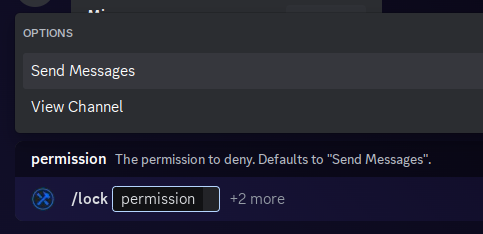Choice Provider vs Auto-complete
What's a choice provider? How is it different from auto-complete? When should you use one over the other?
Choice Providers
Discord provides a special feature to slash command options called "choices." Choices are a list of options that the user can select from. The user can select only from these choices - as in only those choices are valid - which differs from auto-complete. These choices must be known and provided on startup as they're used when registering the slash command. This means that you can't dynamically change the choices at runtime.

Note
The user must choose between only those two options. If the user tries to select something else, Discord will prevent the command from running.
Warning
A choice provider may only provide 25 choices. If you have more than 25 choices, you should use auto-complete.
Auto-complete
Auto-complete, on the other hand, is a feature that allows the user to type in a value and Discord will return a list of suggestions retrieved from your bot. The user can select from the list of suggestions or continue typing. This is useful when you have a large number of options or when the options are dynamic and can change at runtime.

As the user types in the text, Discord will send a request to your bot to get the list of auto-complete suggestions. The user can then select from the list of suggestions or continue typing whatever they want.
Warning
The user is not required to choose from the the suggestions provided. They can send any value they want, and it's up to your bot to handle the value.
Which one should I use?
If you have a small, fixed list of options, use a choice provider. If you have a large list of options or the list of options can change at runtime, use auto-complete.
Some valid use-cases for choice providers include:
- Small Enums (Built-In support!)
- Media types (e.g.
image,video,audio) - The day of the week
Some valid use-cases for auto-complete include:
- Tag names
- A Google search
- Very large enums (e.g. all the countries in the world. Also built-in support!)
Both choice providers and auto-complete support dependency injection through the constructor.
Implementing a Choice Provider
Our class will implement from the IChoiceProvider interface. This interface has a single method: ValueTask<IEnumerable<DiscordApplicationCommandOptionChoice>> ProvideAsync(CommandParameter parameter). This method is only called once per command parameter on startup.
public class DaysOfTheWeekProvider : IChoiceProvider
{
private static readonly IReadOnlyList<DiscordApplicationCommandOptionChoice> daysOfTheWeek =
[
new DiscordApplicationCommandOptionChoice("Sunday", 0),
new DiscordApplicationCommandOptionChoice("Monday", 1),
new DiscordApplicationCommandOptionChoice("Tuesday", 2),
new DiscordApplicationCommandOptionChoice("Wednesday", 3),
new DiscordApplicationCommandOptionChoice("Thursday", 4),
new DiscordApplicationCommandOptionChoice("Friday", 5),
new DiscordApplicationCommandOptionChoice("Saturday", 6),
];
public ValueTask<IEnumerable<DiscordApplicationCommandOptionChoice>> ProvideAsync(CommandParameter parameter) =>
ValueTask.FromResult(daysOfTheWeek);
}
And now we apply this choice provider to a command parameter:
public class ScheduleCommand
{
public async ValueTask ExecuteAsync(CommandContext context, [SlashChoiceProvider<DaysOfTheWeekProvider>] int day)
{
// ...
}
}
Implementing Auto-Complete
Auto-complete is very similar in design to choice providers. Our class will implement the IAutoCompleteProvider interface. This interface has a single method: ValueTask<IEnumerable<DiscordAutoCompleteChoice>> AutoCompleteAsync(AutoCompleteContext context). This method will be called everytime the DiscordClient.InteractionCreated is invoked with a ApplicationCommandType of AutoCompleteRequest.
public class TagNameAutoCompleteProvider : IAutoCompleteProvider
{
private readonly ITagService tagService;
public TagNameAutoCompleteProvider(ITagService tagService) => tagService = tagService;
public ValueTask<IEnumerable<DiscordAutoCompleteChoice>> AutoCompleteAsync(AutoCompleteContext context)
{
var tags = tagService
.GetTags()
.Where(x => x.Name.StartsWith(context.UserInput, StringComparison.OrdinalIgnoreCase))
.ToDictionary(x => x.Name, x => x.Id);
return ValueTask.FromResult(tags);
}
}
And now we apply this auto-complete provider to a command parameter:
public class TagCommand
{
public async ValueTask ExecuteAsync(CommandContext context, [SlashAutoCompleteProvider<TagNameAutoCompleteProvider>] string tagName)
{
// ...
}
}
Simple Auto-Complete
For simple lists of options, the SimpleAutoCompleteProvder class can be derived. This simplifies the process by just asking the developer to have a list of all the choices instead of creating the filtered results list directly.
As an example, you could read a list of supported voice languages from a file and use that to auto-complete the language option of a voice list command.
First the auto-complete provider:
public class LanguageAutoCompleteProvider : SimpleAutoCompleteProvider
{
static DiscordAutoCompleteChoice[] LanguageList = [ .. File.ReadAllLines("data/languages.txt").Select(l => l.Split(' ', 2)).Select(p => new DiscordAutoCompleteChoice(p[1], p[0])) ];
protected override IEnumerable<DiscordAutoCompleteChoice> Choices => LanguageList;
protected override bool AllowDuplicateValues => false;
}
And then tag the command parameter in the same way as before:
public static class ListCommands
{
public static async Task VoiceListCommand(SlashCommandContext ctx, [SlashAutoCompleteProvider<LanguageAutoCompleteProvider>] string language)
{
// ...
}
}
Note
For performance reasons, consider making Choices read from a static array, as in the example above. If Choices reads the file directly, that will happen on every auto-complete request.